RFI’s Standard Control Station Combiner (CSC) is an ideal solution for combining multiple control and dispatch center operators’ radios, or multiple repeater base stations or point-to-point link radios. Their small size also suits their use for repeater base station combining in space-limited applications such as portable repeaters (trailers, command vehicles, etc) and other specialized applications. CSCs provide guaranteed RF isolation performance between each of their ports, allowing predictable protection levels to be achieved between all of the radio equipment connected to it. The ability for multiple radios to co-locate at an installation is important in busy Control and Dispatch room applications, where interference (intermodulation, desensitization or blocking) can degrade communications quality and reliability as radio traffic and channel usage increases – particularly during incidents and other peak workload times.
Models of the CSC are available with port connections to suit either single antenna port (half duplex) radio equipment, or dual antenna port (full duplex) radio equipment types. A Low Noise Amplifier (LNA) option to improve system performance and overcome insertion losses in the Rx signal path, in addition to high-power Tx models for repeater base station combining and other specialized applications, are also available in the CSC product range.
The use of CSCs reduces the number of rooftop antennas (and associated coaxial feeder cables) that are required in multiple-radio installations– reducing tower or building rooftop loading, installation effort, materials and associated costs. This reduction of installation materials can also improve a rooftop’s appearance by reducing the cluttered look of multiple antenna installations, which can assist in the granting of building and development approvals and permits.
Overview
A Standard Control Station Combiner (CSC) is an innovative combiner technology that can combine multiple control and dispatch center operators’ radios, or multiple repeater base stations or point-to-point link radios, to a single set of Tx and Rx antennas when sufficient antenna separation is available – or to a single antenna when used with a suitable duplexer. The inherent design architecture of the CSC provides guaranteed isolation between all of the radio equipment units connected to it, irrespective of the individual ‘transmit’ or ‘receive’ mode of operation, ensuring RF interference problems do not occur between the units and that their communications quality and reliability is not compromised.
CSCs provide the following features:
- Broadband operation
- Models available to suit half-duplex or full-duplex radios
- Rx LNA and High Power Tx models also available
- Available in capacities from 4 to >128 ports
- Compact size. Easily installed and relocated
- Convenient plug’n’play field expandability
- Manages multiple radios’ co-location issues
- Minimizes tower and building rooftop loading
- Reduces site installation costs and effort
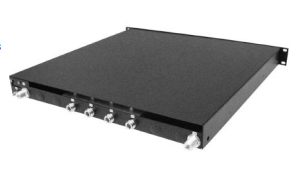
CSCs provide a flexible combining solution across their entire broadband frequency range. This capability is particularly useful in multiple frequency systems, such as trunked radio or voting systems, where the specific frequency of operation for each operator’s radio can vary on a call-by-call basis, or in applications where a control and dispatch center may be coordinating communications across multiple networks and or frequency bands (i.e. VHF, UHF and or 7/8/900MHz).
Control and Dispatch Center Combining
Control rooms often co-locate multiple ‘control stations’ (usually desk-mounted or VOIP/ROIP remotely-connected mobile radios), allowing radio despatchers or operators to communicate with multiple field-based personnel simultaneously.
Depending on the radio system frequencies in use, the simultaneous operation of these multiple control stations can experience co-location interference problems – such as intermodulation, desensitization and blocking – that can degrade the quality and reliability of their communications. This can be particularly true where multi-channel trunked radio systems are being utilized and the actual radio channel frequencies allocated for each call at each control station changes randomly on a call-by-call basis.
Such co-location interference problems can be unacceptable – particularly in operations and mission critical applications, and the CSC can be used to assist in managing these issues in both small and large control room installations.

Multi-Channel RF Link Combining
At many communications sites, multiple RF point-topoint and point-to-multipoint links may be deployed as part of the various systems installed at the site. In many applications, such as wide-area communications networks, open cut mines, processing plants, and military and major infrastructure installations, multiple communications sites may be used to provide extensive coverage across a geographic area. In such situations, and where multiple links are being operated between these sites, a CSC can be used to reduce the number of individual antennas and feeder cables required at the site. This can reduce equipment installation cost and effort, reduce tower or building rooftop loading and clutter, and better manage the intra-system RF isolation between these multiple links and their associated RF equipment.
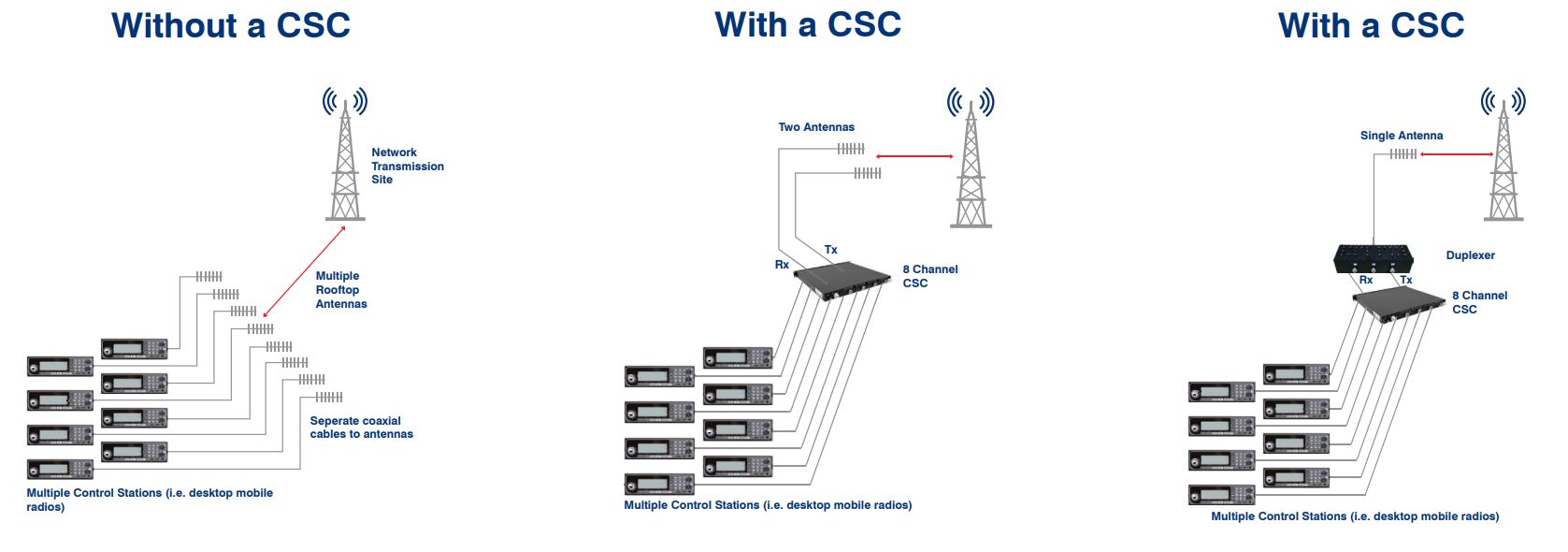
Single Port or Multi-Port Capability
Separate CSC models are available to suit either single port (half-duplex) or dual port (full-duplex) RF equipment. The guaranteed isolation provided between ports in the CSC design provides the flexibility for these different equipment types to be combined to suit a diverse range of wireless technologies and their applications.
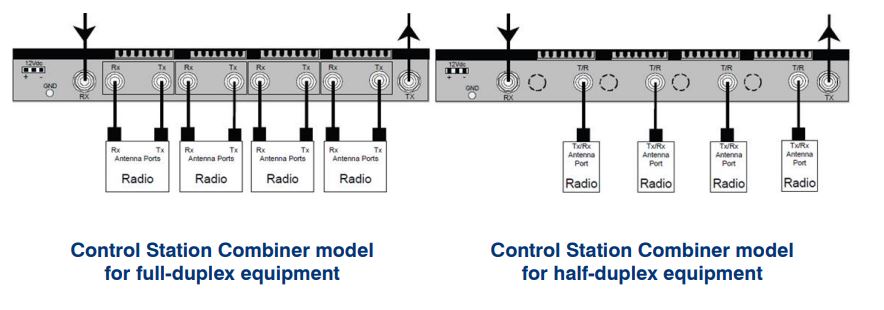
Broadband and Multi-Band Operation
The CSC’s innovative design provides broadband operation across each model’s entire frequency range. This broadband capability suits multichannel operation in conventional and trunked radio systems, and the use of CSCs in these applications allows the rationalizing of coaxial cables in these systems – reducing installation time and costs, and minimizing tower and building rooftop loading and clutter. RFI also offers a comprehensive range of crossband couplers, duplexers and filtering, antennas, and other accessories to support these applications.
Combiner Installation, Capacity and Expandability
The combining of multiple radios can now be realized in a compact 19inch rack mount footprint. CSCs can also be installed directly into ceilings, onto furniture, or in other locations such as beneath stairs, inside cupboards, or into other spaces that may be available in control rooms and dispatch centers, equipment rooms or communications sites where the installation of these combiners may be planned.
CSCs are available using 4 or 8 port model decks. Expansion Decks are also available to enable the creation of multiple CSC configurations catering for various port capacities and expansion capabilities.
CSCs are available for combining capacities from 4 to 128 (or more) ports to suit a wide range of customer applications, with in-field expansions simply and easily installed at any future time as required.
CSC Insertion Loss
The design architecture featured in a CSC is often perceived as having higher-than-desirable insertion loss. However, in most applications, the actual RF link path performance that can be realized provides RF signal levels that are well within acceptable design guidelines.
RF link path modelling, using the transmit powers, cable losses, antenna gains, propagation path losses, receiver sensitivities and desired performance margins can quickly establish if a CSC (or perhaps another combiner type – such as the ‘Short-Haul’ Control Station Combiner) is suitable for use for the specific application or installation scenario.

Applications
Multiple Control Station Dispatch Center
The multiple despatcher mobile radios (control stations) in a busy control center can be combined using a CSC. The CSC provides predictable isolation between all connected radios, irrespective of their transmit or receive operating state, facilitating the co-location and interference-free operation of these units. The quality and reliability of communications in busy operations-critical or mission-critical despatcher environments, particularly during the periods of congested communications when managing major incidents, can be protected and provided using CSC combiners.
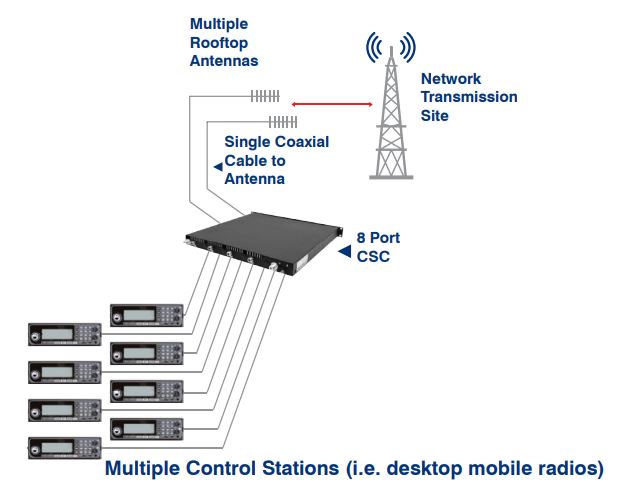
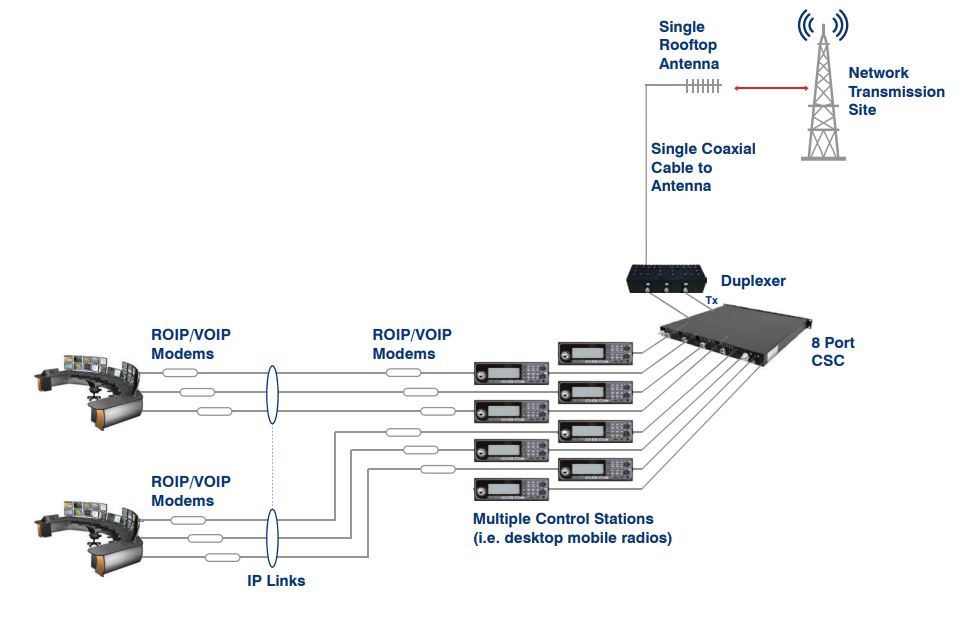
Multiple VOIP/ROIP Operator Consoles
In VOIP/ROIP console installations, despatcher consoles may be connected to remote mobile radios (control stations) or link radios. At the control stations’ or link radios’ location, a Control Station Combiner (CSC) may be used to provide the required RF isolation between the units to ensure their interference-free operation from each other. The benefits of the rationalization of coaxial feeder cables and antennas can also be realized.
Distributed Installation Architecture
A CSC combiner of any capacity can be centrally located and the various items of radio equipment can be cabled to it as desired. However, if radio equipment is located in separate locations (i.e. clustered in furniture pods or in different rooms) then CSC’s may be used to combine each cluster, with the output of each CSC then cabled to a centralized CSC expansion deck which combines the multiple equipment clusters for connection to the one shared antenna. This de-centralized installation approach reduces the overall cabling clutter in cable trays and reduces total installation effort and costs.
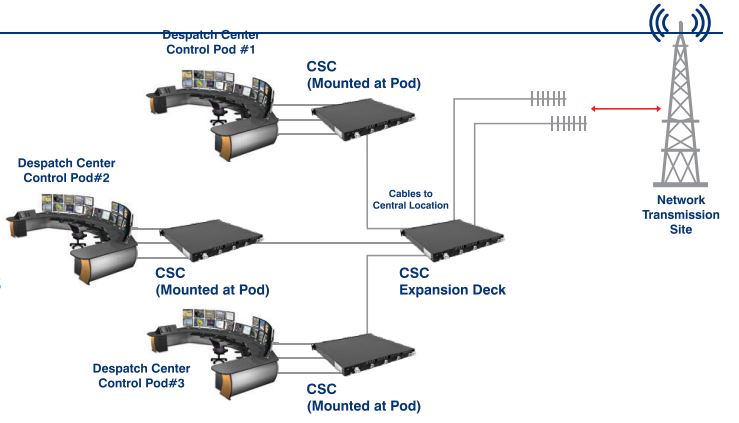
Control Room Back-Up Communications
A busy console-connected dispatch center may utilize mobile radios (control stations) as a method of communications back-up. In these applications, mobile radios are often installed at despatchers’ desks, with coaxial cabling and a multiple rooftop antennas installed pointing towards communications network sites. In the event of console system or IT communications link failures, these mobile radios are used to continue dispatch operations. Installing multiple mobile radios in close proximity to each other often results in interference between units, reducing communications reliability and quality. The use of Control Station Combiners (CSCs) can ensure the required levels of RF isolation between these mobile radios is provided, mitigating these interference problems commonly experienced in these scenarios.
Event & Short Term Rental Radio
Many sporting and other events use a management control or dispatch center as part of their activities. Examples of these may be Race Control or Pit Crews at a car or motorcycle race event, an announcer or event organizer at a music or other community festival. In these scenarios, 2way rental radio providers often deploy transportable short-term communications solutions, with two-way radio network repeaters located in close proximity to the management control center and required event radio coverage area. The CSC provides a compact, cost effective, conveniently deployable, and frequency independent solution for these users. The CSC particularly suits these types of applications, where the operating frequencies may vary on an event-by-event basis, depending on network capacity requirements and the resulting number of channels, and their deployed location, and frequency availability at that location.

Reducing Equipment, Rooftop and Tower Congestion
The use of a CSC allows multiple wireless communications equipment items to be combined together, sharing coaxial feeder cables and antenna systems. This rationalizing of cabling, antennas, and antenna mounting hardware can significantly reduce cable tray congestion, weight and wind loading impacts on building rooftops and towers, and the reduction in the quantity of installation materials also reduces installation labor time and materials costs. In development-sensitive locations, reducing the number of visible cables and antennas can reduce the installation’s environmental impact, and potentially assisting the granting of development approvals and construction permits.
Confined Space/Portable Communications Combining
CSCs provide an ideal repeater base station combining solution for confined installation spaces such as portable communications systems, trailer repeaters, and incident command vehicles. The CSCs small size and mechanically robust construction particularly suits portable trailer and command vehicle communications where the shock and vibration of deployment can be an issue for some other types of combining. A Low Noise Amplifier (LNA) option to improve system performance and overcome insertion losses in the Rx signal path, in addition to high-power Tx models for repeater base station combining and other specialized applications, are also available in the CSC product range.
Example Configurations
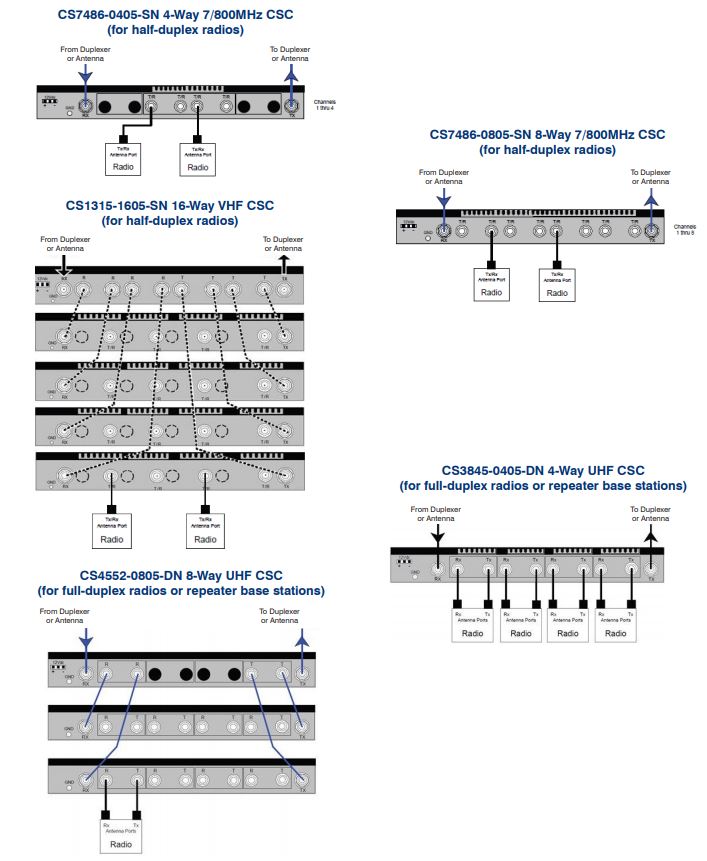
Features & Benefits
- Broadband operation enables the use of a CSC across multiple frequency sub-bands, or an entire frequency band.
- CSC models are available to suit a wide range of radio operation types and capacity requirements. Single RF port (half-duplex) or dual RF port (full-duplex) models are available, with port capacities between 4 and 128 (or more) using the CSC product’s convenient and easy to use “building block” architecture.
- The CSC’s compact size and weight reduces installation space requirements. A 4 port VHF or UHF, or 8 port 7/8/900MHz unit only requires 1RU of 19 inch rack space – or SC’s can be mounted directly onto walls, in ceiling spaces, inside consoles, behind furniture, or into many other available installation locations.
- CSC Headend units are also available to combine multiple layers of CSC architecture. Expansions of CSC combiners can be easily and conveniently carried out in the field – allowing these combiners to be expanded or re-configured to keep pace with customers’ changing needs.
- Centralized or Distributed installation architectures can be used to optimise the CSC installation within a control or dispatch room, equipment room, or other location. The ability to distribute the CSC combiner across multiple locations (rooms, floor or buildings) allow cabling to be rationalized and installation time and cost to be minimized.
- The guaranteed port-to-port isolation and insertion loss performance of the CSC allows the potential problems of coloading multiple units of RF equipment in a small area to be managed. When not managed, these problems can cause interference (Intermodulation, desensitization, or blocking) between units that can degrade communications quality and reliability as radio traffic and channel usage increases – particularly during incidents and other peak workload times.
- The ability of a CSC to combine multiple control stations or link radios to a single antenna can significantly reduce the number of antennas and associated coaxial feeder cables on a tower or building rooftop – also reducing the structure’s loading and clutter, and making an installation less visually impacting – particularly in sensitive development approval and permit locations.
